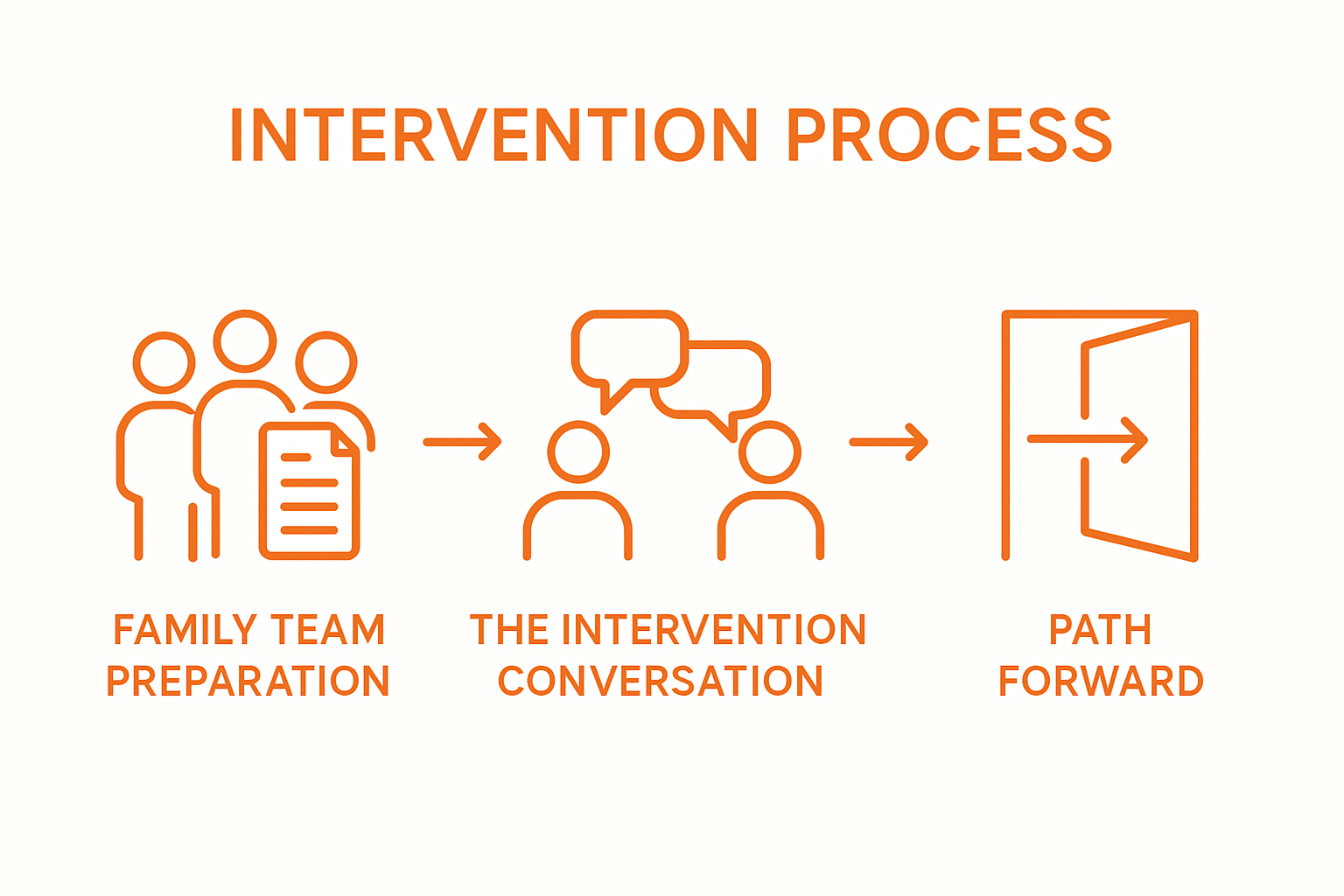Organizing an intervention for a loved one struggling with addiction takes more than just good intentions. Family involvement can significantly improve long-term recovery outcomes, according to addiction recovery experts. Most people believe that interventions are dramatic confrontations pulled from TV dramas. The real surprise is that the actual preparation and follow-up play a much bigger role in creating lasting change than the big meeting itself.
Table of Contents
- Step 1: Gather Information And Resources
- Step 2: Assemble Your Support Team
- Step 3: Plan Your Messaging And Structure
- Step 4: Execute The Intervention With Empathy
- Step 5: Follow Up And Provide Support
Quick Summary
| Key Point | Explanation |
|---|---|
| 1. Gather thorough information first | Document specific behaviors related to addiction to build a persuasive case for intervention. |
| 2. Assemble a supportive intervention team | Select compassionate individuals with positive relationships to provide a united front during the intervention. |
| 3. Plan a structured intervention message | Create clear, emotional statements to convey love and support while addressing the addiction issues. |
| 4. Execute with empathy and calmness | Begin the intervention gently, focusing on love and concern to encourage openness from your loved one. |
| 5. Follow up consistently after intervention | Maintain communication and support as your loved one navigates their recovery journey to improve outcomes. |
Step 1: Gather Information and Resources
Preparing for an intervention requires strategic planning and comprehensive research. This critical first step establishes the foundation for a successful and compassionate approach to helping your loved one recognize their substance use disorder and seek treatment. Before confronting your family member or friend, you must collect detailed information about their specific addiction, available treatment options, and support resources.
Begin by documenting specific instances of destructive behavior directly related to substance use. These concrete examples will serve as powerful, non-confrontational evidence during the intervention. Compile a detailed record including dates, specific incidents, and how their addiction has impacted personal relationships, professional performance, and overall quality of life. For instance, note missed work days, financial problems, relationship conflicts, or health complications resulting from their substance use.
Research treatment programs becomes your next crucial task. According to SAMHSA’s National Helpline, understanding available rehabilitation options is essential. Look for comprehensive programs that offer medically supervised detox, individualized treatment plans, and ongoing support. Consider factors such as:- Inpatient versus outpatient treatment- Specialized addiction recovery programs- Mental health support services- Insurance coverage and financial optionsProfessional consultation can significantly enhance your intervention strategy. Reach out to addiction counselors, therapists, or intervention specialists who can provide expert guidance. These professionals can help you develop a structured approach, anticipate potential challenges, and prepare emotionally for the intervention. They may also recommend specific communication techniques that increase the likelihood of your loved one accepting help.
Gather a support network of family members and close friends who will participate in the intervention. Select individuals who have genuine, positive relationships with the person struggling with addiction. Each participant should be prepared to share their observations compassionately and offer specific support during the recovery process.
Finally, compile a comprehensive information packet that includes treatment program details, insurance information, and immediate next steps. This resource demonstrates your commitment to supporting their recovery and provides a clear pathway forward. The packet should feel like a lifeline of hope, not a punishment, showing your loved one that professional help and a path to healing are readily available.
Here is a checklist to help you ensure thorough preparation before holding an intervention, based on the core recommendations from the article.
| Preparation Task | Description | Completion Status |
|---|---|---|
| Document behaviors | Record specific incidents, dates, and impacts of addiction | [ ] |
| Research treatment options | Gather information on rehab programs, insurance, and support | [ ] |
| Consult professionals | Seek guidance from counselors or intervention specialists | [ ] |
| Assemble intervention team | Select supportive individuals with positive relationships | [ ] |
| Prepare information packet | Compile treatment and insurance details, next steps packet | [ ] |
Step 2: Assemble Your Support Team
Building a compassionate and strategic support team is crucial for a successful intervention. This carefully selected group will serve as the foundation of your intervention, providing emotional support, collective wisdom, and a unified approach to helping your loved one recognize their substance use disorder. The right team can make the difference between a confrontational encounter and a transformative moment of healing.
Choose team members who have a genuine, positive relationship with the person struggling with addiction. According to Mayo Clinic, the most effective intervention participants are those who can remain calm, communicate compassionately, and demonstrate authentic care. Ideal team members typically include close family members, trusted friends, and potentially a professional interventionist who can guide the process professionally.
Consider the emotional dynamics and personal history of each potential team member. Some individuals may have complex relationships or unresolved conflicts that could derail the intervention. Carefully evaluate each person’s ability to remain composed, speak honestly, and focus on supporting recovery rather than expressing personal anger or resentment. The goal is to create a supportive environment that feels loving and constructive, not accusatory or punitive.
Plan a private, preparatory meeting with your support team before the actual intervention. During this meeting, establish clear guidelines and expectations. Create a structured approach where each participant understands their role and prepares their specific message. Develop a united strategy that emphasizes love, concern, and a commitment to supporting the individual’s recovery journey. Some key preparation points include:- Agreeing on a consistent, compassionate tone- Preparing specific, non-judgmental examples of how addiction has impacted their life- Establishing a predetermined treatment option or rehabilitation program- Defining clear boundaries and potential consequences if treatment is refusedEnsure that each team member is emotionally prepared for potential challenging responses. The person might react with denial, anger, or resistance. Your team must remain united, calm, and focused on the ultimate goal of helping your loved one seek treatment. Practicing potential scenarios and discussing potential emotional reactions can help team members feel more confident and prepared.
Finally, consider including a professional interventionist who can provide expert guidance and mediation. These specialists can help manage emotional dynamics, ensure the conversation remains productive, and increase the likelihood of a successful outcome. Their expertise can be invaluable in navigating complex family dynamics and creating a structured, compassionate approach to addressing substance use disorder.
Step 3: Plan Your Messaging and Structure
Crafting a compassionate, clear, and structured intervention message requires careful preparation and strategic communication. This critical step transforms your intervention from a potential confrontation into a meaningful dialogue about recovery and healing. The language and approach you choose can significantly impact your loved one’s willingness to accept help and begin their journey toward recovery.
Begin by developing individual statements that are personal, specific, and rooted in love and genuine concern. Each team member should prepare a carefully constructed message that highlights the impact of addiction on their relationship and expresses unwavering support for recovery. These statements must balance emotional honesty with compassion, avoiding blame or judgment. Focus on concrete examples of how substance use has affected the individual’s life, relationships, and potential for future happiness.
According to addiction intervention experts, the most effective interventions follow a structured format that creates a safe, supportive environment. Develop a clear intervention script that outlines the sequence of sharing, ensuring each participant has an opportunity to speak. Consider the emotional flow of the conversation, starting with expressions of love and concern, moving through specific examples of destructive behavior, and concluding with a concrete treatment plan and offer of immediate support.
Prepare for potential emotional responses by anticipating defensive reactions or attempts to deflect the conversation. Your team should practice responding with empathy and staying focused on the primary goal of getting your loved one into treatment. Some key preparation strategies include:- Maintaining a calm, loving tone throughout the intervention- Avoiding accusatory language or past grievances- Having treatment options and immediate next steps readily available- Preparing for potential denial, anger, or emotional withdrawalConsider the physical setting for the intervention carefully. Choose a neutral, private location where your loved one feels safe but cannot easily escape the conversation. The environment should feel supportive and intimate, allowing for open and honest communication. Timing is equally crucial – select a moment when the individual is likely to be sober and relatively calm.
Develop a clear, unified message about treatment options. Research specific rehabilitation programs in advance and have detailed information ready. Be prepared to offer immediate support, whether that means driving them to a treatment center, helping with insurance paperwork, or providing emotional reassurance.

Step 4: Execute the Intervention with Empathy
Executing an intervention requires a delicate balance of compassion, honesty, and unwavering support. This crucial moment represents the culmination of your careful preparation, transforming months or years of concern into a pivotal opportunity for healing and recovery. The success of the intervention hinges not on confrontation, but on creating a safe emotional space where your loved one feels heard, understood, and genuinely supported.
Begin the intervention by establishing a calm, loving atmosphere. The first moments are critical in setting the tone for the entire conversation. Have the team member with the strongest, most positive relationship speak first, opening with expressions of love and genuine concern. This approach helps prevent the individual from feeling attacked or defensive. Speak from a place of love, not judgment, emphasizing that the intervention comes from a deep desire to help them reclaim their life from addiction.
According to addiction intervention specialists, maintaining a consistent, compassionate tone is essential. Each team member should share their prepared statements using “I” language that focuses on personal feelings and observations. For example, instead of saying “You are destroying your life,” say “I feel worried about your health and future when I see how substance use is impacting you.” This approach reduces defensiveness and creates space for genuine communication.
Prepare for potential emotional responses by remaining calm and united as a team. Your loved one might experience a range of reactions, including:- Denial and anger- Emotional withdrawal- Attempts to manipulate the situation- Sudden emotional breakdown or vulnerabilityRegardless of their initial response, maintain a consistent message of love and support. Listen actively, showing that you hear their feelings while remaining committed to the goal of getting them into treatment. If the conversation becomes heated, take a collective breath and return to the core message of support and hope.
This table summarizes common emotional responses during an intervention, explains what they mean, and provides recommended team responses, helping readers prepare for possible scenarios.
| Likely Response | What It Looks Like | Team Approach |
|---|---|---|
| Denial | “I don’t have a problem,” minimizing issues | Stay calm, repeat concerns with concrete examples |
| Anger | Raised voice, blaming, or lashing out | Don’t argue; acknowledge feelings, restate support |
| Emotional withdrawal | Silence, refusing to engage, leaving the room | Offer reassurance, give space, gently redirect |
| Manipulation | Making promises without intent to follow through | Stay united, avoid negotiating, stay on message |
| Vulnerability/breakdown | Crying, admitting struggles, showing emotion | Offer immediate support, present treatment options |
Have a pre-arranged treatment plan ready to present immediately. This demonstrates that you are not just pointing out a problem, but offering a clear path to recovery. Be prepared to provide immediate logistics, such as transportation to a treatment center, assistance with insurance paperwork, or emotional support during the initial stages of seeking help. The intervention should feel like an extended hand of hope, not a punishment.
Conclude the intervention by giving your loved one an immediate opportunity to accept help. Have a representative from a treatment center available by phone or present in person, ready to guide the next steps. The most successful interventions create a seamless transition from conversation to action, reducing the likelihood of the individual retreating or becoming defensive.

Step 5: Follow Up and Provide Support
The intervention is not a singular event, but the beginning of a long-term recovery journey that requires consistent, compassionate support. This final step represents your ongoing commitment to your loved one’s healing, demanding patience, understanding, and active involvement in their treatment and recovery process. Your continued support can make a significant difference in helping them maintain sobriety and rebuild their life.
Immediate follow-up is crucial in the days and weeks following the intervention. Maintain regular communication with your loved one, showing unwavering support while respecting the boundaries of their treatment program. According to addiction recovery experts, family involvement significantly improves long-term recovery outcomes. Demonstrate your commitment by staying connected, offering practical assistance, and participating in recommended family therapy or support groups.
Establish clear, consistent communication protocols with the treatment facility. Understand the specific guidelines of their rehabilitation program regarding family contact and involvement. Some programs may have structured visitation or communication schedules, while others might recommend more limited interactions during initial treatment phases. Respect these professional recommendations while maintaining a supportive presence.
Prepare for the emotional challenges of supporting a loved one in recovery by developing your own support network. Key strategies include:- Attending family support groups like Al-Anon or SMART Recovery- Seeking individual counseling to process your own emotions- Learning about addiction and recovery from professional resources- Creating healthy boundaries that support recovery without enabling destructive behaviorRecognize that recovery is a complex, nonlinear process. Your loved one may experience setbacks, moments of doubt, or potential relapse. Maintain a compassionate, non-judgmental approach during these challenging times. Instead of expressing disappointment or anger, focus on reinforcing their efforts and redirecting them toward their treatment goals.
Develop a comprehensive long-term support plan that extends beyond initial treatment. This might include helping them create a stable living environment, supporting their participation in ongoing therapy or support groups, and assisting with practical challenges like job searching or rebuilding relationships. Consider connecting them with local recovery resources, vocational training programs, or support networks that can provide additional layers of assistance.
Finally, take care of your own emotional and mental health throughout this journey. Supporting a loved one through addiction recovery can be emotionally exhausting. Seek your own support systems, practice self-care, and remember that your well-being is equally important. Your strength, patience, and continued love can be the most powerful tools in supporting your loved one’s path to lasting recovery.
Take the Next Step Toward Healing
You do not have to face the emotional weight and uncertainty of planning or leading an intervention alone. If you are struggling to find the right words, options, or support for someone you love, remember that real change begins with compassionate action and expert guidance. The pain points described in our step-by-step intervention guide are real. Feelings of helplessness, frustration from failed past conversations, and the daunting task of researching treatment can feel overwhelming. You are seeking not only immediate help, but a trusted resource that provides both proven care and ongoing support for your loved one’s recovery journey.
At Healthy Life Recovery, we help families build bridges to hope. From medically supervised detox to supportive sober living, our team offers the full continuum of addiction treatment, tailored specifically to individual needs. We understand the power of a well-planned intervention and provide both immediate access to evidence-based therapies and the emotional support your family deserves. If you are ready to turn your concern into effective action, visit our rehab programs in San Diego or explore more about how our approach to supportive sober living can sustain lasting change. The first step is within reach—contact Healthy Life Recovery now and discover how your words, and the right treatment partner, can transform a life.
Frequently Asked Questions
What should I say during an intervention?
During an intervention, focus on expressing love and concern. Use ‘I’ statements to share personal feelings and specific examples of how the addiction has impacted your relationship, without sounding accusatory.
How can I prepare for an intervention?
Preparation involves gathering information about your loved one’s addiction, exploring treatment options, creating a support team, and developing a structured message. Role-play potential scenarios with your team to practice your approach.
What if my loved one reacts negatively during the intervention?
Stay calm and united as a team. Validate their feelings but keep the focus on your concern for their well-being. Be prepared for denial or anger and try to guide the conversation back to love, support, and the proposed treatment options.
How important is follow-up after the intervention?
Follow-up is crucial as it demonstrates ongoing support. Stay connected with your loved one during their recovery, attend family therapy sessions if recommended, and be patient as they navigate their path to sobriety.






